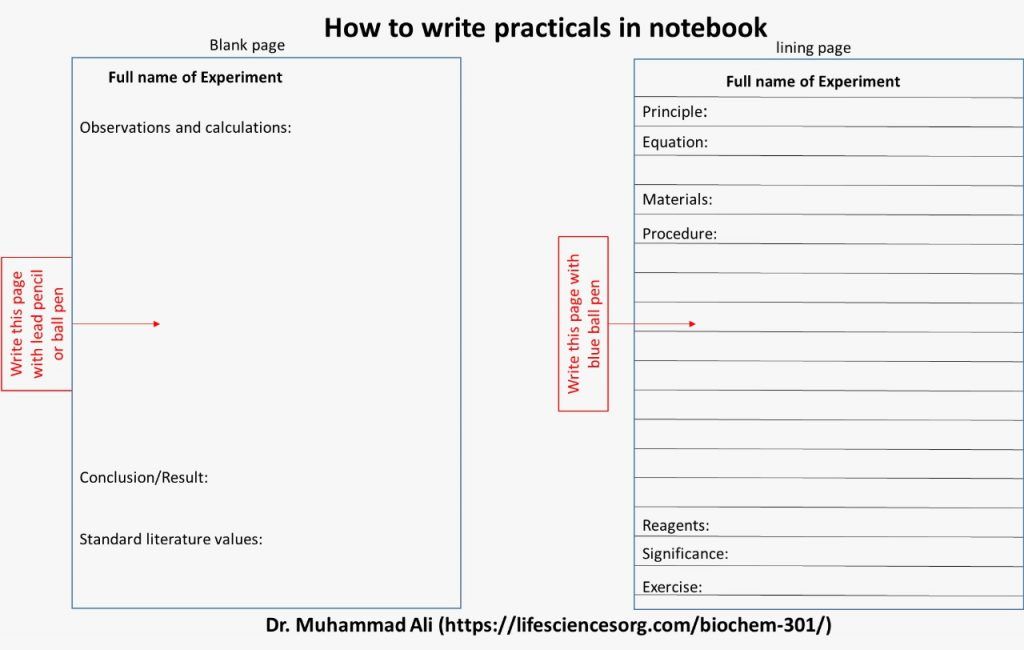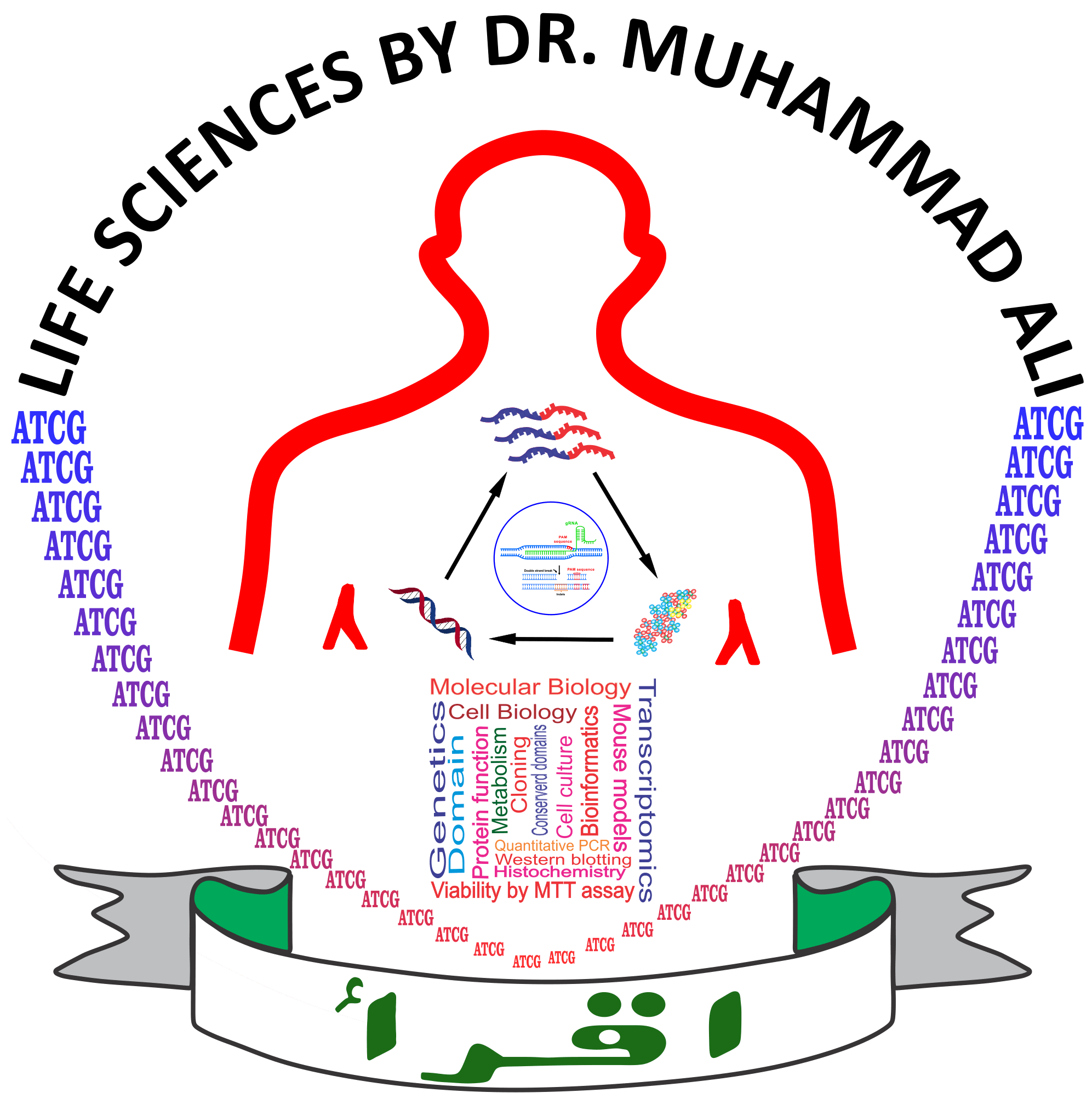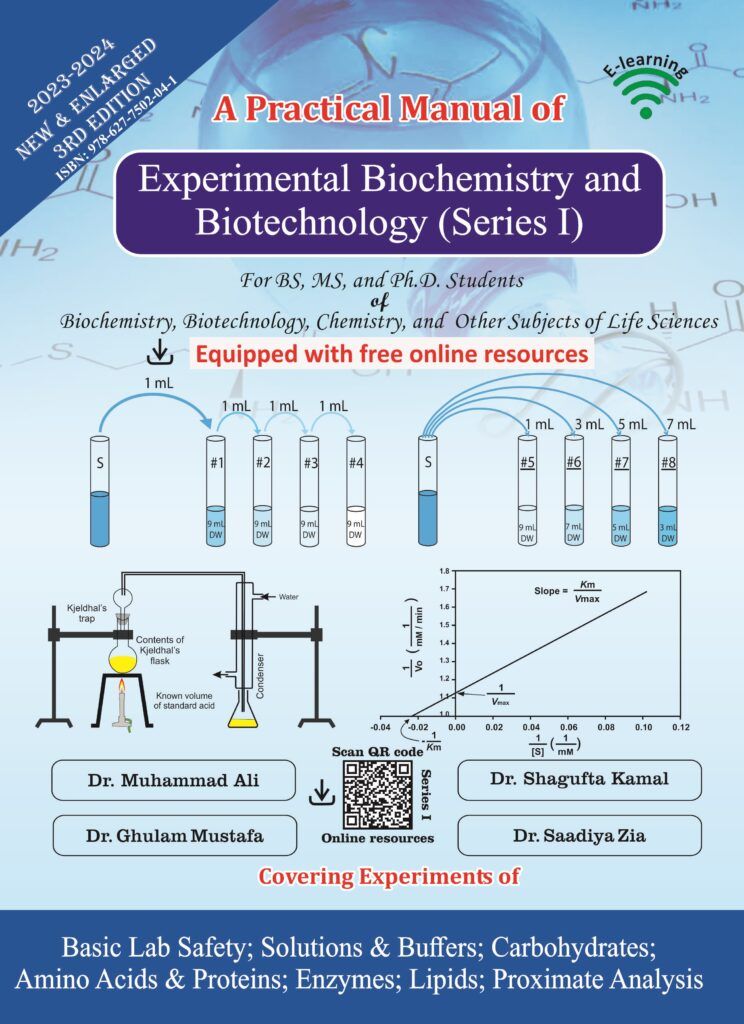Biochem-307 Biochemical Analysis
(list of practical)
- Preparation of solutions: Preparation of Buffer (2.1, 2.4, 2.7-2.9, 2.11, 2.12, 2.22, 2.24)
- Carbohydrate Analysis: Group Identification Test, Identification of mono, di and polysaccharides, Identification of reducing sugars, Identification of ketose sugar and their confirmation by phenylhydrazine test, Identification scheme for carbohydrates, (3.1-3.8)
- Estimation of glucose in blood sample by phenol sulphuric acid method, (3.9, 3.12, 7.3)
- Estimation of amino acids, (4.4)
- Biuret Test and Ninhydrin Test, (4.11, 4.4)
- Precipitation tests of proteins. (5.6)
- Identification of lipids (6.1-6.7)
- Estimation of vitamin C by DCIP method. (7.9)
- Proximate analysis of food/feed samples. (7.1-7.11)
Ali, M. et al., Experimental Biochemistry and Biotechnology (Series I), 2023, 3rd edition, ISBN: 978-969-7502-04-1
Mid-term syllabus of Biochem-307:Solution, colloidal and suspension system. pH & its importance and application, Buffers: natural and synthetic buffers, characteristics of buffer, importance and applications. Henderson-Hasselbalch equation.;
…. PLUS…. First 150 MCQs from chapter 2 (150/302) the book ” MCQs in Biochemistry”. MCQs from the taught concepts and book chapters will also appear in the exam.
Final exam syllabus of Biochem-307: Reaction and mechanism of different biochemical analysis (carbohydrates, proteins, lipids and nucleic acids) and their importance. Proximate analysis, importance and applications. plus 25% of mid-term syllabus
…. PLUS…. First 150 MCQs from each of chapters 2 (150/302) and chapter -3 (150/729) of the book ” MCQs in Biochemistry”. MCQs from the taught concepts and book chapters will also appear in the exam..
……PLUS……… Final exam will contain 30% from mid syllabus.
NO EXCUSE WILL BE ACCEPTED
__________________________________________________________________________________
Meeting ID: 316 824 288 013
Passcode: WNyjeA
Microsoft teams will be used whenever online classes will be held. You must make your first name as your registration number.
2017-ag-9382 Haidar Iftikhar
2017-ag-10077 Ahmad Faraz
__________________________________________________________________________________
Link to download the book ( MCQs in Biochemistry) is given below:
https://b-ok.cc/dl/1055171/2292c5
BIOCHEM-307 BIOCHEMICAL ANALYSIS 3(1 -2)
Course Learning Outcomes
By the end of this course students will be able to;
- 1. Apply an understanding of the methods and techniques associated to solutions, pH and buffers.
- 2. Explain the principles behind major biochemical molecules analysis.
- 3. Demonstrate food and feed analysis.
Theory
Solution, colloidal and suspension system. pH & its importance and application, Buffers: natural and synthetic buffers, characteristics of buffer, importance and applications. Henderson-Hasselbalch equation. Reaction and mechanism of different biochemical analysis (carbohydrates, proteins, lipids and nucleic acids) and their importance. Proximate analysis, importance and applications.
Practical
Preparation of solutions: Preparation of Buffer, Carbohydrate Analysis: Group Identification Test, Identification of mono, di and polysaccharides, Identification of reducing sugars, Identification of ketose sugar and their confirmation by phenylhydrazine test, Identification scheme for carbohydrates, Estimation of glucose in blood sample by phenol sulphuric acid method, Estimation of amino acids, Biuret Test and Ninhydrin Test, Precipitation tests of proteins. Identification of lipids. Estimation of vitamin C by DCIP method. Proximate analysis of food/feed samples.
Suggested Readings
1. Boyer, R.F. 2014. Modern Experimental Biochemistry. 3rd Edition. The Benjamin / Cummings
Publishing Co., USA
2. Nelson, D.L and M.M. Cox. 2017. Lehninger Principles of Biochemistry. 7th ed. Worth Publishers, New York.
3. Murray, R., D. Bender, K.M. Botham, P.J. Kennelly, V. Rodwell and P.A. Weil. 2015. Harper’s Illustrated Biochemistry, 30th edition. The McGraw-Hill companies Inc. USA. ISBN-10: 0071825347
4. Gowenlock, A. H., J.R. McMurray and D.M. McLauchlan. 2006. Varley’s Practical Clinical Biochemistry 6th ed. CBS Publishers and distributors. New Delhi, India.
5. Sawhney, S.K. and R. Singh. 2009. Introductory Practical Biochemistry. Narosa Publishing House, New Delhi, India.
6. Shawn, O.F. and L. E. Taylor. 2009. Biochemistry Lab Manual. Cengage Learning, USA.
7. Ali, M. et al., Experimental Biochemistry and Biotechnology (Series I), 2019, 3rd edition, ISBN: 978-969-7502-04-1
8. Ali, M. et al., Experimental Biochemistry and Biotechnology (Series II), 2019. 1st edition, ISBN: 978-969-23317-2-2.
9. Ali, M. et al., Experimental Biochemistry and Biotechnology (Series III), 2023, 1st edition, ISBN: 978-969-23317-6-0

| 3-Biochem-307 MA,1st, Spring 25, Dr. M ALI (RIGHT AFTER MID EXAM) | ||||
| Sr. | Ag No. | Student’s Name | Group | Topic of practical and number of practical (ppt and presentation) |
| 1 | 2024-ag-8493 | Aaima Ahmad | G1 | 1. Preparation of solutions: Preparation of Buffer (2.1, 2.3, 2.7-2.9, 2.11, 2.12, 2.22, 2.24) |
| 2 | 2024-ag-7750 | Abubakar | ||
| 3 | 2024-ag-8245 | Adha Arshad | ||
| 4 | 2024-ag-8179 | Afsheen Mubashar | ||
| 5 | 2024-ag-4006 | Aleesha Batool Anwar | ||
| 6 | 2024-ag-4399 | Ali Hassnain Shah | G2 | 2-1. Carbohydrate Analysis: Group Identification Test, Identification of mono, di and polysaccharides, Identification of reducing sugars, Identification of ketose sugar and their confirmation by phenylhydrazine test, Identification scheme for carbohydrates, (3.1-3.4) |
| 7 | 2024-ag-7738 | Alisha Fatima | ||
| 8 | 2024-ag-7290 | Amatul Aala Tooba | ||
| 9 | 2024-ag-5916 | Ammara Ahmad | ||
| 10 | 2024-ag-9601 | Amna Bibi | ||
| 11 | 2024-ag-4158 | Amna Jabeen | G3 | 2-2. Carbohydrate Analysis: Group Identification Test, Identification of mono, di and polysaccharides, Identification of reducing sugars, Identification of ketose sugar and their confirmation by phenylhydrazine test, Identification scheme for carbohydrates, (3.5-3.8) |
| 12 | 2024-ag-5711 | Amna jamil | ||
| 13 | 2024-ag-6689 | Ansib Fatima | ||
| 14 | 2024-ag-8478 | Aqsa Ijaz | ||
| 15 | 2024-ag-8566 | Areeba Amjad | ||
| 16 | 2024-ag-8277 | Areeba Mazhar | G4 | 3. Estimation of glucose in blood sample by phenol sulphuric acid method, (3.9, 3.12, 7.3) |
| 17 | 2024-ag-6619 | Arfa Mehmood | ||
| 18 | 2024-ag-8183 | Arooj Asif | ||
| 19 | 2024-ag-8177 | Ayesha | ||
| 20 | 2024-ag-4762 | Ayesha Akbar | ||
| 21 | 2024-ag-8270 | Ayesha Binyamin | G5 | 4. Estimation of amino acids, (4.4) |
| 22 | 2024-ag-6786 | Ayesha Minahil | ||
| 23 | 2024-ag-6910 | Ayesha Qamar | ||
| 24 | 2024-ag-7792 | Bisma Noor | ||
| 25 | 2024-ag-5634 | Dania Zaheer | ||
| 26 | 2024-ag-4457 | Fareeha Azhar | G6 | 5. Biuret Test and Ninhydrin Test, (4.11, 4.4) |
| 27 | 2024-ag-5970 | Fareeha Hameed | ||
| 28 | 2024-ag-7670 | Fatima Saif | ||
| 29 | 2024-ag-7717 | FatimaTanveer Akhtar | ||
| 30 | 2024-ag-8062 | Feham Qaiser | ||
| 31 | 2024-ag-4703 | Fida Imran | G7 | 6. Precipitation tests of proteins. (5.6) |
| 32 | 2024-ag-6756 | Fiza Tariq | ||
| 33 | 2024-ag-6251 | Habiba Almas | ||
| 34 | 2024-ag-8381 | Hiba Asad | ||
| 35 | 2024-ag-9608 | Hifza | ||
| 36 | 2024-ag-7050 | Hooriya Kashif | G8 | 7. Identification of lipids (6.1-6.7) |
| 37 | 2024-ag-6854 | Humna Hussain | ||
| 38 | 2024-ag-7257 | Ifrah Fayyaz | ||
| 39 | 2024-ag-5059 | Iqra Saleem | ||
| 40 | 2024-ag-6531 | Iqra Zahid | G9 | 8. Estimation of vitamin C by DCIP method. (7.9) |
| 41 | Kashaf Shahid | |||
| 42 | 2024-ag-6538 | Kashaf Usman | ||
| 43 | 2024-ag-4314 | Laiba Shahzad | ||
| 44 | 2024-ag-6653 | Laiba Waseem | G10 | 9. Proximate analysis of food/feed samples. (7.1-7.11) |
| 45 | 2024-ag-6512 | Lubaina Hashim | ||
| 46 | 2024-ag-6502 | Muhammad Awais Ali | ||
| 47 | 2020-ag-9210 | Rabia Habib | ||
| 48 | 2023-ag-8519 | Nabiha Majeed | ||
| 49 | 2023-ag-8590 | Eman Fatima | ||
| 50 | 2023-ag- | Muntaha | ||
51

